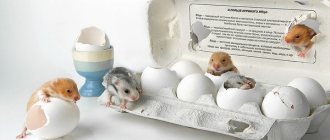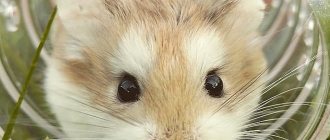For those new to hamster breeding, pregnancy is a real event. And it must be treated responsibly. After all, the slightest mistakes in caring for the expectant mother and her babies after childbirth can lead to the hamster abandoning the babies and even eating them. Therefore, the owner of rodents needs to find out in advance about the mating characteristics of hamsters, the timing of the female’s pregnancy, and also how childbirth proceeds.
How to keep a couple before mating: together or in different cages
Hamsters of this species reproduce well, and in captivity they are able to do this throughout the year. However, for this process they need to create certain conditions. So, before mating, it is better to keep the female and male in different cages, since they can show aggression towards each other - they will fight for territory. They need to be combined in one cage only for the duration of mating.
Note that peaceful coexistence of a boy and a girl in the same room is possible, but this is quite rare. If you do not have the opportunity to buy another cage, then you can place the female with the male for a while. Who knows, what if your couple will be on the list of those rare ones who live in peace and harmony. If the experiment fails, then it will still be necessary to decide to purchase a new cell. It is unlikely that you will like to put up with scratches and scraps of torn fur.
Read on for tips on choosing a cage and ball for your hamster.
You can avoid conflicts if you buy a girl and a boy at the same time and at the same time place them in a new cage. In this case, one male can even get along with several females. You should avoid placing a younger female with a male who has already been living with you for some time. In this case, war cannot be avoided.
Did you know? Experienced breeders have noticed that in a territorial war between males and females, the latter almost always win, and the males are inferior to them.
At what age do jungarians begin to mate?
Puberty in hairy hamsters occurs at 1-2 months. It is better to pair with a younger male and an older female. Ideally, the boy will be 3 months old, and the girl – 4. It is at this age that the female will be ready to take care of the offspring, and childbirth will become safe for her body.
If you still do not have information on how to determine the sex of hamsters, then you can do this already a month after birth. To do this, measure the distance between the animal's anus and genitals while lying on its back. If it is 0.5-1 cm, and in the center of the abdomen there is a small bulge - the male gland, then this is a male. Already at 2-3 months you will be able to see the testicles. If the distance is less than 0.5 cm, and there are 2 rows of nipples on the stomach, then it is a female. The female is also usually slightly larger than the male.
Important! A month after birth, females and males must be placed in different cages.
When can you be separated from your mother?
It is time to separate three-week-old hamsters from their mother; this should be done no later than 4 weeks after birth. At this time, the female may become aggressive towards the children and may even eat them. To exclude the possibility of early reproduction, females are planted separately from males. Otherwise, there is a high probability of getting defective offspring or a lack of maternal instinct in a too young female.
The living conditions should be the same as for adult hamsters: a cage with feeders, drinkers, a house, etc. After 2 months, each hamster will have to be provided with a separate cage, otherwise “wars” for territory will begin.
How to understand that a female needs to be introduced to mating
She will indicate that the female is ready to mate by unusual behavior. Once every 4-5 days, she will often raise her tail, arch her back, and secrete a strong-smelling substance. This is how the female’s sexual activity will manifest itself, which, as a rule, coincides with the follicular stage of the sexual cycle. Scientifically, this process is called estrus, popularly called estrus. Estrus usually begins in the evenings and lasts from 4 hours to a day. At this time, the female becomes favorable to the male, so it is best now to unite them in one cage.
What conditions need to be created for successful reproduction?
To encourage hamsters to mate after uniting them under one roof, you should place a lamp in the immediate vicinity of the cage and direct the light from it into the cage. In this case, the animals will look for a dark corner in their home. This will certainly bring them closer.
The best option for mating would be a separate cage, carrier, or box . This way you can avoid conflict. If this is not possible, then the female is placed with the male, and not vice versa.
The mating cage should be spacious. The room temperature is not lower than 20°C and not higher than 25°C. The cage should be installed in a secluded place where there are no drafts, noise, heating devices, and away from other pets. It is advisable to remove all gaming accessories from it.
Find out more about hamsters: what breed of pet hamster to choose, how long do hamsters of different breeds live, how to train a hamster to respond to its name.
Do not abandon animals immediately after joining without supervision. If a serious fight breaks out, they will need to be seated. You can leave them alone only if it is clear that they like each other.
Since after conception the female will begin to build a nest, she needs to put materials in the cage - rags, cotton wool, clean paper, hay. Placing newspapers in the cage is strictly prohibited.
Why do little hamsters die?
There are several possible causes of death:
- The mother refused to feed the cubs. If the female moves to the opposite end of the cage, you can place her with the offspring on the first day. If the instinct does not manifest itself within 24 hours, it is better to find another provider or give milk to the newborns yourself.
- Congenital injuries.
- Diseases. Most often, cubs die due to milk fever. The pathogen is transmitted through mother's milk. Hamsters become lethargic and have bloating. With timely treatment, young animals can be saved.
- Incorrectly selected diet for the female. A lack of protein will result in decreased milk production. The female can independently destroy the cubs.
Timely measures can often save newborns. However, in some situations, humans are unable to help hamsters.
How do Djungarian hamsters mate?
Sexual intercourse among Djungarians lasts on average about 5 minutes. In general, the process of addiction and familiarization occurs within 20-30 minutes.
Djungarian hamsters usually mate in the dark. The male approaches the female several times with short breaks.
A couple should be placed in different cages when they have lost interest in each other. However, keeping them together for longer than 45 minutes is not recommended.
Do not worry if after mating the male lies down, barely breathing - sexual intercourse requires a lot of energy, so the animal needs time to recuperate. After mating, both the female and the male should be well fed with their favorite treats in the feeder.
Be prepared that it will take several matings to conceive . If 5 days after the first mating the hamster comes into heat again, the mating will need to be repeated. If estrus did not occur, and after some time the girl began to gain weight (usually the tummy becomes slightly noticeable after 10 days), then conception was successful.
Video: reproduction of Djungarian hamsters
How to determine pregnancy
The most reliable way to find out if your hamster is pregnant is to take it to the vet. However, visiting the clinic will be very stressful. A rodent can lose offspring due to fear, so it is better to refrain from traveling.
Visually, pregnancy in dwarf hamsters is very difficult to determine. An attentive owner may still notice some changes in the behavior and appearance of the pet:
- Increased appetite: The hamster comes to the feeder more often than usual.
- Slowness. A pregnant dwarf becomes more attentive and can rarely be seen running on a wheel.
- Enlarged belly. In the middle of the term, it is already clearly visible that the female figure has become rounded.
- Approximately 12-14 days after pregnancy, the Djungarian hamster begins to build a nest.
What to feed a pregnant female
A pregnant hamster needs to create comfortable conditions, ensure complete peace and absence of stress. Remember that stressful situations can have a detrimental effect on the offspring, even to the point of a distraught mother devouring her children.
The hamster should also be provided with good nutrition. At this time, her diet should contain a lot of fruits, vegetables and products containing protein, which is so necessary during the development of the offspring in the womb . The latter include:
- egg white;
- chicken meat (boiled);
- baby food with meat;
- dairy products.
Learn more about hamster nutrition.
Also, at this moment the female urgently needs to replenish her body with minerals. To do this, place a chalk stone in the cage.
Important! Good nutrition for the mother will guarantee that she will not bite the babies to death.
.
Feeding the female after giving birth
Pregnancy, childbirth and feeding are a burden on the animal’s body, and sometimes even with good nutrition the hamster loses weight. Therefore, the nutrition of a female who has given birth and that of an adult differs.
The volume of the grain mixture for a nursing female needs to be doubled, in addition to it, food rich in proteins needs to be added to the diet. It is necessary to give the female hamster greens daily.
Experts recommend feeding the animal several times a week with low-fat boiled meat, low-fat cottage cheese or a boiled egg. It is also advisable to pamper your hamster with seeds or nuts.
It is important to remember that babies will also be introduced to food together with their mother, so the food must be crushed.
In addition to proper nutrition, your hamster needs more water. It is necessary to ensure that there is fresh water in the drinking bowl at all times.
How many hamsters are born to Djungarians?
A female Djungarian hamster is maximally capable of bearing 18 babies. Usually one individual has from 5 to 9 children.
Under no circumstances should you interfere with the birth process. It is better not to approach the cage at all, so as not to scare off the female. Childbirth lasts from 1 to 2 hours. The intervals between babies coming out are on average about 15 minutes.
Newborns are born tiny, bald and blind. Babies' eyes open after 2 weeks.
How long does pregnancy last and number of babies?
The shortest duration of pregnancy in female Syrian hamsters is 16 days. The number of cubs varies between 6-12, maybe less. Rarely occurs anymore. The maximum gestation period for Syrian hamsters is 20 days.
In dwarf hamsters, pregnancy will last 3 weeks. To be even more precise, a maximum of 22 days, taking into account the day of conception. One litter can have 4-7 cubs. Rarely does the number reach 9. In hamsters, there is a relationship between the number of fetuses and the length of pregnancy: the more cubs, the shorter the gestation period.
Care of offspring
After giving birth, the mother needs rest - at least for a week. After this time, she will again be ready to mate and conceive.
A nursing mother will need good nutrition and a constant supply of clean water . It is advisable to purchase special food at a pet store so that the hamster’s breast milk is as rich as possible in the vitamins and minerals necessary for the normal development of healthy offspring.
The cage where the babies are located must be spacious - at least 50 by 30 cm. The temperature in the room where the babies live must be maintained at 21-25°C . The house with newborns should be in a shaded, quiet place.
Thus, the owner must create all favorable conditions for the new mother, but not interfere in the process of caring for the babies.
If the mother nevertheless abandoned the cubs, then you need to try to feed them yourself. For this you will need baby formula. However, the chances of survival for abandoned babies are low.
Conditions of detention
Proper maintenance will affect the future health of the animals.
Improvement of the cell
When arranging the cage, consider the following aspects:
- Litter. Avoid using patches made of artificial fabric or cotton wool. Newborns may suffocate if exposed to such materials.
- Special security. Make sure that babies cannot get out of the cage on their own. If this does happen, do not pick them up to return them to the house. Better use a spoon.
- Avoid tiers. Select cages with a small distance between the bars so that the baby cannot fall out.
- Drinking bowl. If there is water in an open container, the hamsters may drown. It is better to install a container with a spout through which the animals can independently extract liquid when they grow up a little.
- Calm. The house should be located in a place away from sources of direct bright light. It is better to put the cage in a room inaccessible to children so that noise and constant attention do not disturb the female.
Is it possible to pick up small jungarians?
Experienced breeders do not advise touching or picking up babies until they reach two weeks of age. Also, until this time, it is worth climbing into the cage with your hands less often, only to carry out the necessary manipulations of replacing water and providing food. The litter is not changed at this time.
The most popular of all types of domestic hamsters is the Syrian; families with children love it.
The fact is that any careless actions can scare away the mother, and in this case she will stop fulfilling her parental responsibilities. There is a big risk that she will stop feeding the children if she smells someone else's smell on them.
How to care for newborn hamsters?
When the babies are born, the mother leaves them in the nest, warms them with her warmth and feeds them. You cannot change the filler during this period and touch the cubs. The female will protect her offspring and become angry. So when can you clean your cage? Replace the bedding when the animals get a little stronger and open their eyes. The approximate period is 2 weeks after birth. By that time, the adult hamster will already get tired of sitting in the dirt; he himself will want cleanliness and comfort.
After cleaning the home, you can sprinkle shelled sunflower seeds around the entire perimeter of the cage so that the youngsters learn to find food on their own.
Important! Miniature hamsters will easily fit through bars, so temporarily reinforce the bottom of the cage with aluminum sheeting!
Some hamsters abandon their babies, there may be several reasons for this:
- the female herself is too young, she gave birth before the age of 3 months, so the maternal instinct has not yet developed in her;
- stressful situations discourage you from feeding;
- there are too many hamsters in the litter, there is not enough milk for everyone;
- exhaustion of the body, illness;
- foreign odors (if you hold the babies in your hands, the pet may refuse to recognize them).
These reasons can not only discourage the hamster from feeding, but lead to her trying to strangle or eat her own offspring.
Self-feeding
And sometimes it happens that a pet dies during the birth of babies. In this case, you will have to care for newborn hamsters yourself. Alas, most of the offspring without maternal care may die. Your task is to save the life of at least part of the offspring.
There are 2 options for the development of events:
- Place the newborns with another female hamster who has recently given birth and has milk. The difficulty is that it is not always possible to find such a replacement, and the new mother may not recognize other people’s children.
- Feed tiny creatures yourself.
Let us warn you right away that this task is very difficult, because babies need food every hour! During the first week you will have to get up at night much more often than with a human child. Feeding newborn hamsters has its own nuances. For the first 7 days, try to feed them every 1-1.5 hours so that the little ones gain strength faster.
- babies need special food: your task is to find a special hamster milk substitute in pet stores or veterinary pharmacies;
- dilute the food according to the instructions: it should be warm;
- Place the mixture in a small pipette. Syringes can also be used;
- place the crumb on your hand, squeeze a drop of the mixture from the pipette;
- touch the animal’s nose so that it licks the food;
- Make sure your hamster doesn't choke.
Starting from the 8th day of life, gradually increase the interval between feedings to 2-3 hours and introduce complementary foods of peeled seeds and vegetables. When the animals open their eyes, you can feed them with a pipette only 2-3 times a day. Don’t forget to adjust the position of the drinking bowl spout so that the animals can reach it. By the age of one month they are already eating on their own.
Attention! At the age of 1 month, it is necessary to place girls and boys in different cages, otherwise the Homies will begin to multiply exponentially!
Taming
If you feed hamsters from birth, then they are already tame. But if the mother took care of the children, then you can pick them up when she allows. This usually occurs by 2 weeks of age.
Handle the younger generation carefully, because newborn hamsters need an eye and an eye! They can easily jump out of your hand and hurt yourself. But you can’t squeeze the tiny body either: the bones of hamsters are not yet strong, and you can easily break your pet’s legs or ribs.
For 1-2 month old animals, you can already install attractions. It's very funny to watch how the already pubescent lump runs in the wheel! Take young hamsters on a slide and offer them delicious food. And then you can slowly train the hamsters. New owners will be pleasantly surprised if they get a trained hamster!
When can you give away hamsters after birth?
Hamsters develop very quickly, so already at the age of one month they can be given into the wrong hands. Until the 21st day, they should be close to their mother. Then, no later than the 28th day, they should be removed. They must live in a separate cage for some time before being sold. The new owner should be given some bedding from the old cage and food so that the babies quickly adapt to an unusual place - a familiar smell and familiar food will reduce stress.











